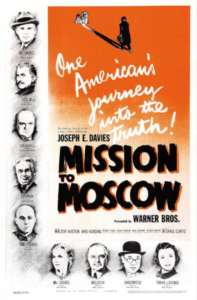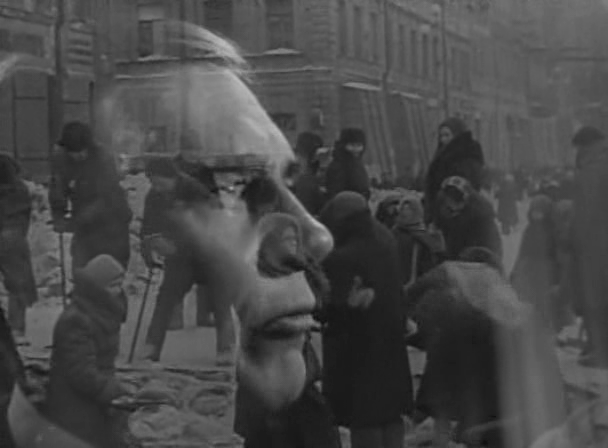“At least one European nation without aggressive intentions is ready for anything that comes — and I say, thank God for it.”
|

Synopsis:
Roosevelt’s second ambassador to the Soviet Union — Joseph E. Davies (Walter Huston) — shares his positive impressions of life in Stalinist Russia, urging the U.S. to join forces with Stalin (Manart Kippen) against Nazi Germany.
|
|
Genres, Themes, Actors, and Directors:
- Eleanor Parker Films
- Michael Curtiz Films
- Walter Huston Films
- World War II
Review:
This rather astonishing piece of pro-Russia wartime propaganda, produced by Warner Brothers Studios and given full approval by the Office of War Information, presents a cinematic version of Ambassador Davies’ popular 1941 memoir, wherein he asserted that the Soviet Union had been sorely misunderstood and unfairly maligned. As he (played by Huston) says directly to Stalin (Kippen) in the film:
“I’ve been greatly impressed by what I’ve seen — your industrial plants, the development of natural resources, and the work being done to improve living conditions everywhere in Russia. I believe, sir, that history will record you as a great builder for the benefit of mankind.”
DVD Savant accurately refers to the film as “an amazingly didactic speech-fest with almost zero dramatic value,” adding that “insidious is the only word for the film’s whitewash of Stalin’s actions and the motives behind them.” Indeed, critics on both sides of the political aisle — in America and Russia — took issue with the many inaccuracies on display here, perhaps most notably the one-sided view of the murderous Moscow Trials. Mission to Moscow remains merely a cinematic curiosity, and certainly not must-see viewing for film fanatics.
Redeeming Qualities and Moments:
- Bert Glennon’s cinematography


Must See?
No. Listed as a film with Historical Importance in the back of Peary’s book.
Links:
|



One thought on “Mission to Moscow (1943)”
First viewing. Not must-see – which is what I determine: whether or not it’s a film that most film fanatics should be aware of. (Nowadays it’s little-talked-about.)
Its actual worth as an historical document is another matter and I will leave that to the experts; which I’m not and I don’t pretend to be.
TCM’s website quotes producer Jack L. Warner (speaking before the HUAC Committee in 1947) re: the film’s purpose: “The picture was made when our country was fighting for its existence, with Russia as one of our allies. It was made to fulfill the same wartime purpose for which we made such other pictures as ‘Air Force’, ‘This Is the Army’ …and a great many more. If making ‘Mission to Moscow’ in 1942 was subversive activity, then the American Liberty ships which carried food and guns to Russian allies and the American naval vessels which convoyed them were likewise engaged in subversive activities. This picture was made only to help a desperate war effort and not for posterity….” (Howard Koch, who wrote the ‘MTM’ script, was placed on the Hollywood blacklist.)
An accusation of being subversive is one thing; being realistic is another. Wikipedia tells us: “According to film historian Robert Osborne, ‘… When it was shown in Moscow, despite all the good will, people who saw it considered it a comedy—its portrayal of average, everyday life in the Soviet Union apparently way off the mark for 1943.'”
As well, “When the Russian composer Dimitri Shostakovich saw it, he observed that no Soviet propaganda agency would dare to present such outrageous lies.” [Miles, Jonathan (2010) The Dangerous Otto Katz. New York: Bloomsbury. p.255]
Its inaccuracies aside, director Michael Curtiz at least approached the material in his usual professional way. He supplied it with as much urgency as possible – so I don’t particularly agree with DVD Savant that it’s “with almost zero dramatic value”.
Its problematic depiction of Stalin aside, there’s a great deal in the film that rings true so it’s not particularly one to be completely ignored. Its value may indeed be that of a “curiosity”, but it may be of interest to viewers who study its subject matter.